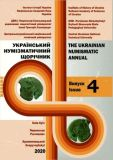ЗНАХІДКИ В БАСЕЙНІ р. ТЯСМИНУ МІДНИХ МОНЕТ ОЛЬВІЇ З ДЕМЕТРОЮ ТА «ІСТРІЙСЬКИМ» ВАРІАНТОМ МІСЬКОЇ ЕМБЛЕМИ
THE FINDS IN THE RIVER BASIN OF TIASMYN COPPER COINS OF OLBIA WITH THE DEMETER AND «ISTRIAN» VARIANT OF THE CITY EMBLEM
Author(s): Vasyl OrlykSubject(s): Archaeology, Economic history, Ancient World
Published by: ДВНЗ Переяслав-Хмельницький державний педагогічний університет імені Григорія Сковороди
Keywords: river basin of Tiasmyn; Olbia; city emblem; obol; ancient Greek coins; coin find; Dnieper Right-Bank forest-steppe;
Summary/Abstract: The problems of the ancient history population of the Tiasmyn River basin have certain coverage in the scientific literature. Historiography contains references about the ancient Greek coins finds, mainly of the 6th – 5th centuries BC and coins of the Roman Empire in this region. At the same time there is no information about the finds of coins minted in the IV century BC. However, there are the finds of ancient Greek coins of the IV century BC, including quite rare ones in the area of Tiasmyn basin and in general on the territory of the Dnieper Right-Bank forest-steppe. Among the corpus of the ancient Greek coins on the territory of the basin of Tiasmyn, a special place is occupied by the coins from the Greek colony Olbia in the North-Western Black Sea region. The article is devoted to the review of finds, namely copper coins with the Demeter and the «Istrian» version of the city emblem in the basin of the Tiasmyn River. Researchers often define the denomination of this type of coins as «Obol». The first coin of this type was found near the village of Rozumivka in the Oleksandrivka district of the Kirovohrad region in 2019. And the second coin was found in Chyhyryn district of Cherkasy region in the spring of 2020. The historiography contains information about the names of coin magistrates, which were responsible for issuing this type of coins. The number of these names according to different investigators ranges from 14 to 20. However, this number of names should probably be larger. The first of the coins described in the article is well minted on both sides and has characteristic features of this type, which are related with the technology of minting. These features were described by P. Karyshkovsky, in particular, it is the presence of a clearly defined and deeply indented circular recess on the reverse. Exactly this technological feature of this type of coin allows us to identify the legends on the reverse clearly, because they are contained only within the boundaries of this recess. A detailed study of this coin using the MBS – 9 stereoscopic microscope allowed the author to maintain that the inscription АПОΛ is complete and there are no remains of other letters of this inscription on the coin. This is the first and so far the only coin with such different published in the article. It is known that a minor figure who had the name Ἀπολλωφάνης lived in the third quarter of the IV century BC in Olbia. The activity of this Olbiopolite chronologically coincides with one of the periods of minting of this type of coins defined by P. Karyshkovsky and V. Anokhin, so it is quite possible that he was the coin magistrate, at which the coin with the АПОΛ different was minted. Thus, data from onomastic and prosopography indicate that this type of copper coins with the Demeter and the «Istrian» version of the city emblem could have been minted in the third quarter of the IV century BC, and not earlier as it E. Turovsky suggests. The article notes that the combination of prosopographic and numismatic methods is a considerably promising direction of scientific research. The obols with the Demeter and the «Istrian» version of the city emblem, which are analyzed in the article, are the first coins of this type introduced into the scientific circulation; the coins were founded far beyond the Olbian Chora, which significantly expands the known topography of this type of the coin finds. The finds of the coins minted in the IV century BC in the Greek colony of Olbia in the Tiasmyn River basin on the territory of the Oleksandrivka district of Kirovohrad and Chyhyryn district of Cherkasy regions, demonstrate the existing connections of the population in the Tiasmyn River basin with the Greek cities of the NorthWestern Black Sea region in the specified chronological period. The finds of ancient Greek coins on the territory of the Dnieper Right-Bank forest-steppe, including in the area of the river basin Tiasmyn, refute the prevailing view in historiography that the inhabitants of the Middle Dnieper had exclusively commodity exchange operations with the Greek colonies in the Northern Black Sea region; and bronze coins, that accidentally and in small volumes fell to this region, could be used as raw materials for the manufacture of bronze objects.
Journal: Український Нумізматичний Щорічник
- Issue Year: 2020
- Issue No: 4
- Page Range: 5-13
- Page Count: 9
- Language: Ukrainian

